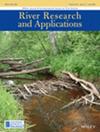Predicting nature recovery for river restoration planning and ecological assessment: A case study from England, 1991–2042
IF 1.9
4区 环境科学与生态学
Q4 ENVIRONMENTAL SCIENCES
引用次数: 0
Abstract
The Global Biodiversity Framework established ambitious goals for nature recovery which governments must now incorporate into national legislation. In England, legally binding targets require authorities to halt the decline in species abundance by 2030 and reverse the decline by 2042. Riverine invertebrates represent a substantial proportion of the species contributing towards the targets. Thus, understanding the response of these species to potential river restoration actions is key to target delivery. We model counts for 188 riverine invertebrate taxa using zero-inflated generalized Poisson models, applying the models to both inform river restoration planning and set expected values for use in ecological assessment. We identify catchment-specific restoration strategies that combine one or more actions involving the removal of channel modifications, reductions in nitrate concentrations and reductions in total dissolved phosphorus concentrations as the most likely to deliver species abundance targets across three joint climate–socioeconomic scenarios. By hindcasting species abundances under alternative target frameworks, we also demonstrate a new approach to setting expected values in ecological assessment, accounting for changes in water temperature and hydrology that confound historical reference models presently used by regulators. Our findings represent the first systematic attempt to prioritise major actions to deliver species abundance targets in England, providing valuable insights for policymakers, river restoration practitioners and authorities responsible for monitoring river ecosystems.为河流恢复规划和生态评估预测自然恢复:英格兰案例研究,1991-2042 年
全球生物多样性框架制定了雄心勃勃的自然恢复目标,各国政府现在必须将这些目标纳入国家立法。在英格兰,具有法律约束力的目标要求当局在 2030 年前阻止物种数量的下降,并在 2042 年前扭转下降趋势。在实现这些目标的物种中,河流无脊椎动物占了很大比例。因此,了解这些物种对潜在河流恢复行动的反应是实现目标的关键。我们使用零膨胀广义泊松模型对 188 种河流无脊椎动物分类群的计数进行建模,并将模型应用于河流修复规划,同时设定预期值用于生态评估。我们发现,在三种气候-社会-经济联合情景下,结合一种或多种涉及消除河道改造、降低硝酸盐浓度和降低总溶解磷浓度的行动的特定流域恢复战略最有可能实现物种丰度目标。通过对替代目标框架下的物种丰度进行后报,我们还展示了一种在生态评估中设定预期值的新方法,该方法考虑到了水温和水文的变化,这些变化对监管机构目前使用的历史参考模型造成了混淆。我们的研究结果是首次系统性地尝试对英格兰实现物种丰度目标的主要行动进行优先排序,为政策制定者、河流修复实践者和负责监测河流生态系统的机构提供了宝贵的见解。
本文章由计算机程序翻译,如有差异,请以英文原文为准。
求助全文
约1分钟内获得全文
求助全文
来源期刊

River Research and Applications
环境科学-环境科学
CiteScore
4.60
自引率
9.10%
发文量
158
审稿时长
6 months
期刊介绍:
River Research and Applications , previously published as Regulated Rivers: Research and Management (1987-2001), is an international journal dedicated to the promotion of basic and applied scientific research on rivers. The journal publishes original scientific and technical papers on biological, ecological, geomorphological, hydrological, engineering and geographical aspects related to rivers in both the developed and developing world. Papers showing how basic studies and new science can be of use in applied problems associated with river management, regulation and restoration are encouraged as is interdisciplinary research concerned directly or indirectly with river management problems.
 求助内容:
求助内容: 应助结果提醒方式:
应助结果提醒方式:


